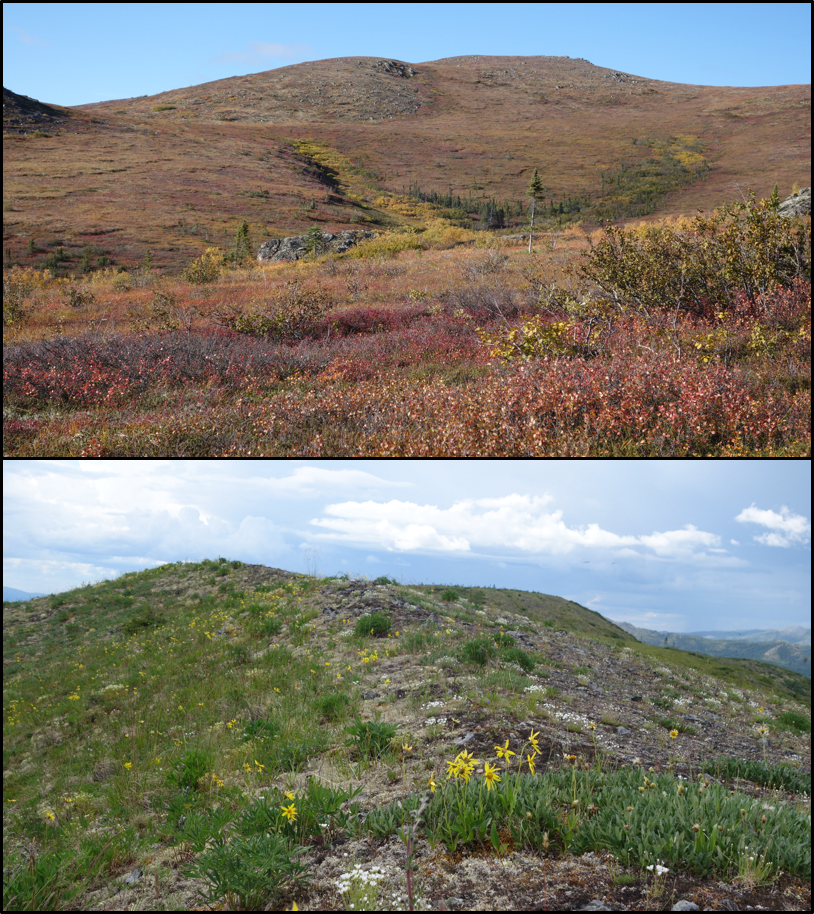November 16, 2021
Exploring Model Parameter Uncertainty across Arctic Tundra Plant Communities
Model sensitivity and uncertainty to a given parameter varied spatially across the highly heterogeneous arctic tundra plant communities, illustrating the complexity inherent in evaluating parameter uncertainty across highly heterogeneous arctic tundra plant communities

Heterogeneous plant tundra communities in northern Alaska.
[Courtesy Eugenie Euskirchen.]
The Science
One fundamental uncertainty in terrestrial biosphere models relates to model parameters, configuration variables internal to the model whose value can be estimated from data. To address this uncertainty, a team of researchers incorporated a version of the Terrestrial Ecosystem Model (TEM) developed for arctic ecosystems into the Predictive Ecosystem Analyzer (PEcAn) framework. PEcAn treats model parameters as probability distributions, estimates parameters based on a synthesis of available field data, and then quantifies both model sensitivity and uncertainty to a given parameter or suite of parameters. The team examined how variation in 21 parameters in the equation for gross primary production influenced model sensitivity and uncertainty in terms of two carbon fluxes (net primary productivity and heterotrophic respiration) and two carbon (C) pools (vegetation C and soil C). Different parameterizations of TEM were set up across a range of tundra types (tussock tundra, heath tundra, wet sedge tundra, and shrub tundra) in northern Alaska, along a latitudinal transect extending from the coastal plain near Utqiaġvik to the southern foothills of the Brooks Range, to the Seward Peninsula.
The Impact
This study illustrates the complexity inherent in evaluating parameter uncertainty across highly heterogeneous arctic tundra plant communities. It also provides a framework for iteratively testing how newly collected field data related to key parameters may result in more effective forecasting of Arctic change.
Summary
TEM was most sensitive to parameters related to the temperature regulation of photosynthesis. Model uncertainty was mostly due to parameters related to leaf area, temperature regulation of photosynthesis, and leaf stomatal responses to ambient light conditions. Results also showed that sensitivity and uncertainty to a given parameter varied spatially. At some sites, model sensitivity and uncertainty tended to be connected to a wider range of parameters, underlining the importance of assessing tundra community processes across environmental gradients or geographic locations. Generally, across sites, the flux of net primary productivity (NPP) and pool of vegetation C had nearly equal uncertainty, while respiration from soil microbes had higher uncertainty than the pool of soil C.
Principal Investigator
Eugénie Euskirchen
University of Alaska Fairbanks
[email protected]
Program Manager
Daniel Stover
U.S. Department of Energy, Biological and Environmental Research (SC-33)
Environmental System Science
[email protected]
Funding
The U.S. Department of Energy’s (DOE) Office of Biological and Environmental Research (BER) provided funding for this work as part of the Next‐Generation Ecosystem Experiments in the Arctic (NGEE-Arctic) project, as well as DOE grant No. DE-SC0016219 and DE-SC0012704. Funding was also provided by the U.S. Geological Survey, Research Work Order 224 to the University of Alaska Fairbanks.
References
Euskirchen, E.S., et al. "Assessing Dynamic Vegetation Model Uncertainty in Alaskan Arctic Tundra Plant Communities." Ecological Applications, e02499 (2021). https://doi.org/10.1002/eap.2499.

